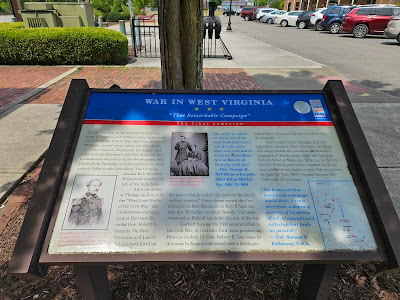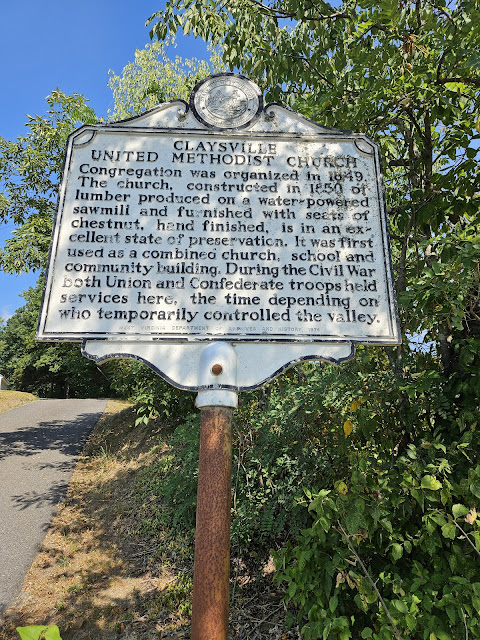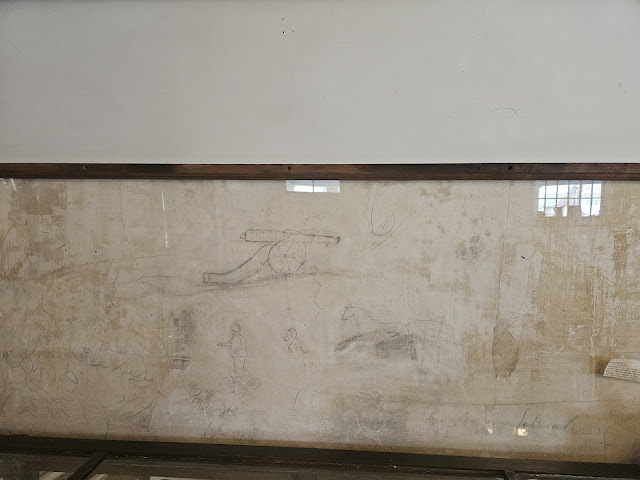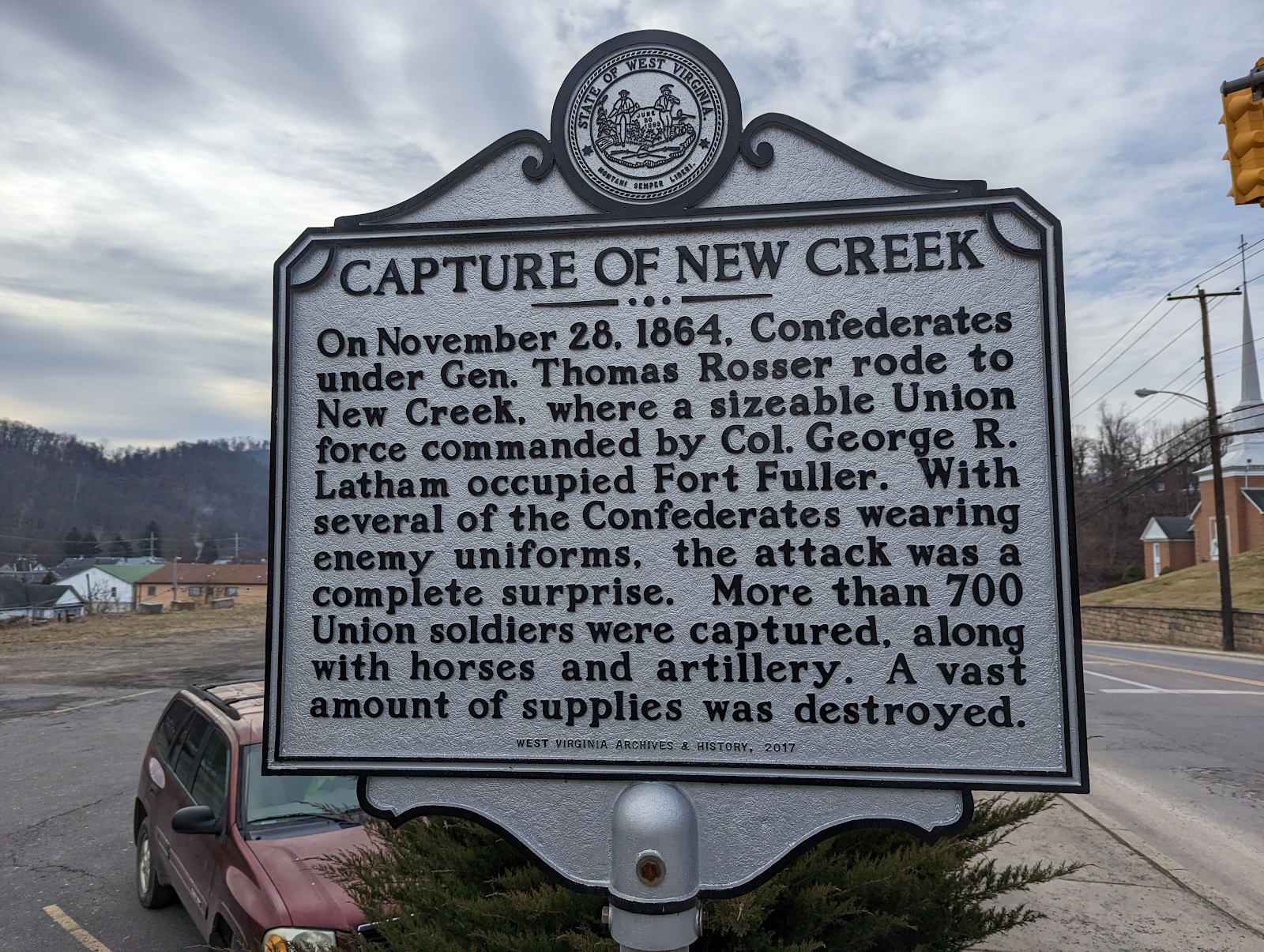Summer 1861
The First Campaign
West[ern] Virginia (various WV sites)
There are many remote places to visit in WV that are associated with the Civil War but that may not be associated with one particular date. The town of Beverly, which saw action and changed hands multiple times throughout the war, is a perfect example. Visiting these places, I sometimes felt like I was the only one. Often the historical markers I sought were destroyed or in such disrepair as to be unreadable. While I found markers that nobody had entered into the database before, more often I was confirming the absence of one for the first time. People were nice in WV, but most don't seem too invested in preserving their history. And wow are their roads bad. Also, nobody in the state's 161 years of existence has ever asked the very important question: "Where are we gonna work when the trees/coal are gone?"
Anyway, here's Elkins, WV first.
 |
| https://www.hmdb.org/m.asp?m=23238 |
War in West Virginia
"That Remarkable Campaign"
— The First Campaign —
You are standing at the heart of the first campaign of America's Civil War, looking west toward Rich Mountain. Late in May 1861, Gen. George B. McClellan moved troops across the Ohio River "to secure Western Virginia for the Union" and to protect the Baltimore and Ohio Railroad. The Confederates wanted to secure the Staunton and Parkersburg Turnpike, a vital road from the Shenandoah Valley to the Ohio River. The turnpike crossed Rich Mountain through the notch to the left of the radio towers.
After the defeat at Philippi on June 3 in the "First Land Battle of the Civil War," the Confederates reorganized at Huttonsville under Gen. Robert S. Garnett. On Rich Mountain and Laurel Hill, Garnett fortified the passes that he called "the gates to the Northwestern country." Union forces routed the Confederates on Rich Mountain on July 11, and the next day McClellan occupied Beverly. This area remained in Federal hands for the rest of the war.
Garnett became the first general killed in the Civil War, at Corrick's Ford (near present-day Parsons) on July 13. Gen. Robert E. Lee came to this area in August and established a headquarters at Valley Mountain but failed to drive out the Federals.
These small Union triumphs had two important outcomes. First, President Abraham Lincoln promoted the victorious McClellan to command all Union armies after the shocking Federal defeat at Manassas, Virginia, on July 21. Second, Federal control here allowed the fledgling statehood movement to grow. Two years later, on June 20, 1863, West Virginia became the 35th state of the Union.
The valley in which we are is one of the most beautiful I ever saw & I am more than ever inclined to make my Head Quarters at Beverly & have you with me."
- Gen. George B. McClellan to his wife, Mary Ellen McClellan, July 13, 1861
"The history of that remarkable campaign would show, if truly portrayed, a degree of severity, of hardship, of toil, of exposure and suffering that finds no parallel."
- Col. Samuel V. Fulkerson, C.S.A.
 |
Yea - been to ALL these places,
but this page is for First Campaign markers without a singular date. |
 |
| Not actually an historical marker, but here we are |
And while we are in Elkins: they call this the Iron Horse statue, even though it is not actually called that. It's basically in the middle of the road: there's no parking so there's no good shot of it. This guy was alive during the Civil War at least. IDK, read this, which covers Davis, for whom Davis, WV is undoubtedly named, as well as the esteemed Stephen Benton Elkins, for whom Elkins is name.  |
https://www.hmdb.org/m.asp?m=9371
Henry Gassaway Davis |
Born November 16, 1823, Died March 11, 1916.
Benefactor • Philanthropist • Railway Builder.
Worked as if he were to live forever. Lives as if he were to die to-morrow.
* * *
This random church I ran across is outside New Creek, WV, near the Maryland border.
https://www.hmdb.org/m.asp?m=36836
* * *
It could technically go under the "July 11, 1861- Rich Mountain," but let's talk about Beverly, WV now. Their Heritage Days celebration was the excuse I needed to revisit the area (Fall 2024) - after my first nearly fatal attempt to traverse Rich Mountain last winter (more on that tragedy is covered in the Rich Mountain entry). I did not regret attending Heritage Days! It had reenactors, clog dancing(?), good food, and a Parade of History. There were definitely points where I was the only person watching the small parade; I had a good time. The museum does a great job with The First Campaign; I took too many pics.
https://www.hmdb.org/m.asp?m=261671
Beverly and Civil War "Firsts"
Crossroads of Conflict
The Civil War brought repeated conflict to Beverly, and many Civil War "firsts" occurred here. U.S. Gen. George McClellan launched the war's first campaign from this strategic crossroads. His forces, assisted by local guide David Hart, defeated Confederates at Rich Mountain on July 11, 18731. McClellan then occupied the town, which remained under Union control for most of the war though major Confederate raids swept through here in 1863 and 1865. Beverly also witnessed the first amputation by a Confederate surgeon, the first mass surrender of prisoners, and the first use of a telegraph in wartime.
Start your journey at the Beverly Heritage Center, and then wander our historic town to see building containing graffiti written throughout the conflict, a Union hospital, McClellan's headquarters, and the telegraph office he used to proclaim the victory that started his rise to fame as the North's first battlefield hero. Make sure to visit nearby Rich Mountain Battlefield.
[sidebar] The Beverly Heritage Center contain Gen. McClellan's headquarters and the original Randolph County Courthouse. A Union hospital was established in the David Geoff House. The Logan House was the site of the first amputation by a Confederate surgeon. Soldier graces from every American war can be found in the Beverly Cemetery.
Laura Jackson Arnold (1826-1911) lived in Beverly during the Civil War. Her brother was Gen. Thomas "Stonewall" Jackson. Although her husband and brother supported the Confederacy, Laura was a Union sympathizer. During the Civil War, she nursed troops of both sides.
https://www.hmdb.org/m.asp?m=159015
 |
| I got a Christmas ornament in the shape of this building- McClellan's HQ |
This house, located on a part of original town lot #4, was built about 1850. It was the home of Bushrod Crawford who also operated a store in the building with his brother Absalom. Brushrod Crawford ran against John Hughes in February of 1861 for Delegate to the State Convention to be held in Richmond, Va. Bushrod favored secession; Hughes did not. Hughes was elected, but changed his mind at the convention and voted for secession. Bushrod, Absalom, and their families fled south in July of 1861, as did many others in Beverly, leaving the store vacant for the Federals to occupy.
While in Beverly in July of 1861, General McClellan made his headquarters here. The telegraph office was moved to this building from the home of Bushrod's brother, Adam Crawford. Federal troops remained in Beverly throughout the war, and continued to use this building for a headquarters.
"We have annihilated the enemy in Western Virginia ... Our success is complete and secession is killed in this country."
General George B. McClellan
Telegram from Beverly, July 14, 1861
The 6 bay two-story building has a front facing ell which was the store wing. A two-story four-bay porch with lattice and square posts crosses the front. The traditional entrance door is divided wood with flat-headed transom and divided sidelights. The building once had 9/6 windows and an entrance door for the store onto the sidewalk where the west front window is now placed.
 |
| Beverly Bank (1900), now part of their museum |
And this adjacent building was the Randolph Co. Courthouse
Looks like a bunch of markers on the other side of the street, so let's go check them out too! 
 |
| https://www.hmdb.org/m.asp?m=159011 |
The Blackman-Bosworth Store building was built 1827-28 by David Blackman on lot #14. It originally stood next to the James Westfall log house that had been used as an early courthouse. Slaves built the store building, supervised by bricklayer J.W. Bradley who had a brick yard along the river. Mr. Blackman had a mercantile store here until the Civil War. The store was later operated by McClaskey and Hanshaw.
The store has a vault in the cellar, reached by a trapdoor, which was used to store valuables before there was a town bank. The building was used as a commissary during the Civil War, and at times was a post office and a print shop; the Randolph Enterprise newspaper was first printed here.
In 1881, Squire Newton Bosworth, the son of Dr. Squire Bosworth, bought the store. In the 1890s, he built an addition on the north side of the building. His descendants lived here until the building was sold to the Randolph County Historical Society in 1972.
The Blackman-Bosworth Store is individually listed on the National Register of Historic Places.
Now the Randolph County Museum, this is a three-bay by four-bay structure with 9 over 6 pane windows and large double doors. On the north side is an 1890s addition with separate entrance.

 |
| https://www.hmdb.org/m.asp?m=24561 |
Beverly
Original County Seat
Nearly two decades after the ill-fated attempt of the Foyles (Files) and Taggert (Tygart) families to pioneer the area in 1754, the Tygarts Valley was finally settled by a group of families in 1772. One of this group, Jacob Westfall Sr., built a fort near the Files home site where Files Creek empties into the Tygarts Valley River. Several log homes built by these early pioneers still survive within existing buildings in the area.
When Randolph County was established in 1787, plans were made for a county seat, to be called Edmundton in honor of the governor, Edmund Jennings Randolph. In 1790, the town was laid out in one-half acre lots on the lands of James Westfall and renamed Beverly, for the new governor, Beverly Randolph.
Beverly developed as the county seat and commercial center of a rich farming valley. With the completion of the Staunton-Parkersburg Turnpike in 1845, the community prospered, boasting a wide range of products and services. The Beverly-Fairmont Turnpike was completed in 1852, giving access to the new railroad that reached Grafton the same year.
Troops occupied Beverly throughout the Civil War, serving as a staging area for Confederate troops before Rich Mountain, and headquarters for Federal troops afterwards. The town was raided several times during the war, and a number of buildings were destroyed.
After the War, Beverly again prospered, adding many new homes and buildings. Its prosperity was eclipsed by the new railroad boomtown of Elkins in the 1890s, however, and the County Seat was moved to Elkins in 1900.
 |
| https://www.hmdb.org/m.asp?m=155078 |
Occupied Beverly
Caught in the Midst of Conflict
Life in Beverly changed following the Union victory at Rich Mountain on July 11, 1861. Many of the community’s outspoken Southern sympathizers fled south. Some of those who remained resented the hardship that came with Union occupation, although Laura Ann Jackson Arnold, Stonewall Jackson’s sister, gladly cared for wounded Federal solders under her roof. Travel was restricted, many townspeople were compelled to board soldiers, and some had their property taken or destroyed by the army.
Aware of the strategic importance of Beverly for control of the Staunton and Parkersburg Turnpike, Union garrisons were maintained here to support actions throughout western Virginia. In November 1863, Union Gen. William W. Averell led his forces from here down the Huntersville road on his East Tennessee and Virginia Railroad raid, which included the Federal victory at Droop Mountain on November 6, 1863.
Confederate forces challenged Federal control of Beverly in four significant raids by Gen. William E. Jones—Gen. John D. Imboden, April 24, 1863; Col. William L. Jackson, July 2, 1863; Capt. Hannibal Hill, October 29, 1864 and Gen. Thomas L. Rosser, January 11, 1865. Only the Jones-Imboden and Rosser raids were successful.
• Jones-Imboden Raid, April 24, 1863: Gen John D. Imboden's cavalry drove out Union Col. George R. Latham's garrison and occupied Beverly for about 5 days.
• Col. William L. Jackson's Raid, July 2, 1863: Jackson attempted to take the town from Union Col. Thomas M. Harris's forces, but the Federals held Beverly Heights (Mount Iser) and repelled the attack.
• Capt. Hannibal Hill's Raid, October 29, 1864: Hill's 62nd Virginia Mounted Infantry struck the town before dawn, hoping to seize horses. They rode into the 8th Ohio Cavalry camp just as the regiment had formed for roll call and were driven away in a fierce engagement.
• Gen. Thomas L. Rosser's Raid, January 11, 1865: Rosser rode here from Staunton to take horses, food, and arms, and succeeded where Hill had failed. Thomas Arnold, Stonewall Jackson's nephew, wrote that "the fight...hardly lasted longer than half an hour, and was a complete Confederate success. The Federals, such as were not captured, retreated, fighting through the streets of Beverly and across the bridge on the road leading to Buckhannon." Rosser was back in Staunton by January 18.
 |
| https://www.hmdb.org/m.asp?m=239896 |
Beverly
Crossroads of Conflict
— The First Campaign —
Situated at a crossroads on the Staunton-Parkersburg Turnpike, Beverly was a strategic location and proved to be a focal point during the Civil War. There were no large plantations here and political opinions were split, yet the majority of Beverly's citizens favored the South.
From the beginning of the Civil War, Beverly was a staging area for local militia and troops sent from eastern Virginia to serve the Confederacy.
Following Federal success at Rich Mountain, Gen. George McClellan led his troops into Beverly and secured this vital crossroads for the Union. Confederates raided Beverly several times during the war, but the Union retained control. McClellan sent many of his famous victory telegrams from here.
A number of local families with Confederate connections fled south, as Beverly was occupied by Federal troops during most of the war. Troops dug trenches around Mt. Iser, overlooking the town. After the war, a cemetery for Confederate dead was created within these entrenchments.
A number of the buildings tied to Civil War events here still stand.
"The next day (following the Battle of Rich Mountain) bout 11 a.m., the Federals advanced (into Beverly), followed by numerous regiments in handsome uniform with banners flying, keeping exact step to the music of the fine Regimental Bands, playing the beautiful March from the opera, 'Norma.' Many of them were well-drilled, crack regiments - many Germans, having had their military training abroad - some regulars... the several regiments went into camp in the vicinity of town."
-Thomas Jackson Arnold

 |
| https://www.hmdb.org/m.asp?m=193394 |
The First Campaign
Civil War Begins in the Mountains of (West) Virginia
— The First Campaign —
West Virginia, born of a nation divided, was the setting for the first campaign of America's Civil War. Although still part of Virginia in 1861, many citizens of the west remained loyal to the Union, rather than the Confederacy. By late May, Union General George B. McClellan, commanding the Department of the Ohio, launched the first campaign, ordering troops to cross the Ohio River and secure "Western" Virginia for the Union.
Here, during June-July 1861, McClellan's army won the inaugural Union victories of the Civil War. Hailed as the North's first battlefield hero, McClellan was summoned to Washington on July 22, following a stunning Union debacle at Manassas, Virginia. Federal troops now occupied Western Virginia, as loyal delegates met in Wheeling to form the "Restored Government of Virginia," a Union government to oppose the Confederate one in Richmond.
By August 1861, Southern forces again threatened. Confederate General Robert E. Lee attempted to reclaim Western Virginia, but failed miserably. Troops of both armies remained to guard the mountain passes during that terrible winter. By 1862, conflict shifted east. The first campaign proved to be decisive: the western counties under Union control became the new state of West Virginia in 1863. The arduous conflict in these mountains forged armies and leaders-notably McClellan, Lee, and Stonewall Jackson-who shaped the course of the Civil War.
"The history of that remarkable campaign would show, if truly portrayed, a degree of severity, of hardship, of toil, of exposure and suffering that finds no parallel."
Col. Samuel V. Fulkerson, C.S.A.
https://www.hmdb.org/m.asp?m=158229

Built around 1792, this is one of the oldest standing houses in Beverly. It was altered to its present form circa 1835 and purchased by Adam Crawford in 1846. Union officers occupied the house after the Battle of Rich Mountain. According to tradition, the telegraph wires brought by General McClellan's advancing army were strung to the tree on the left side of the house, and the telegraph office was established in the upper left hand bedroom. It is possible that General McClellan's famous victory telegram was sent from this location.
The Crawford family was forced to live in one room during much of the Union occupation, to the chagrin of the staunch southerners. One of the daughters, Harriet, later married a Union telegrapher she met here, but only after inducing him to desert and join the Confederate Army instead.
A typical "I-house" with 2 rooms upstairs, 2 rooms downstairs and a central entry and hall, this home features some Federal style detailing. This circa 1880s photograph gives a clear view of the house, including the unusual 9/6 windows which were found in many Beverly buildings. A later photo from around 1900 shows the windows had been changed by that time.
 |
https://www.hmdb.org/m.asp?m=24579
https://www.hmdb.org/m.asp?m=151996
This Stone Commemorates: Robert Foyles & Family, killed by Indians 1753, half mi. Settlement of David Tygart, 2 mi. S. near bridge. First English settlers west of Alleghenies.
Westfalls Fort, built 1774, half mi. S.
Battle of Rich Mountain, 5 mi. W. July 11, 1861. Gen. Geo. B. McClellan commanding Federals. Maj. John Pegram, Confederates, lasted 3 1/2 hrs., between Gen. Rosencrans with four regiments assisted by Col. Lauder, and Capt. J.A. DeLaguel with 310 soldiers. Confederates defeated.
|
 |
| https://www.hmdb.org/m.asp?m=24518 |
Edward Hart, son of John Hart who was a signer of the Declaration of Independence, purchased the house standing here in 1795. Col. David Goff, a prominent Beverly lawyer, purchased it in 1830, and added the larger front portion of the house, possibly with Lemuel Chenoweth as the builder.
A colonel in the Virginia militia, Goff was an active supporter of the Confederacy and was instrumental in organizing the Confederate build-up in Beverly during the earliest days of the war. On the day of the Battle of Rich Mountain, Colonel Goff together with his family fled south for safety.
The vacated house was used as an official U.S. Army hospital during the war. Extensive graffiti on the walls of the house testify to this occupation.
"Beverly Union Hospital"
Hand lettered sign on front room wall.
This distinguished five-bay Federal style house has 6/6 windows with a central tripartite window on the second floor. The entrance door has decorative sidelights and divided transom, and the cornice has decorative scroll brackets. The broad porch with paneled columns wrapping around the front and both sides of the house was an early 20th century addition; most other add-ons have been removed in recent restoration work, leaving the house closer to its 19th century appearance. The original carriage house and tack room still stand behind it.
Here's the Goff House and mediocre pics of some of that 161-year old graffiti, which they left on the walls and framed!
 |
| https://www.hmdb.org/m.asp?m=23349 |
And yea, that's Rich Mountain, over the bridge out of town.
https://www.hmdb.org/m.asp?m=165103
https://www.hmdb.org/m.asp?m=164653
Laura Jackson Arnold, sister of Thomas "Stonewall" Jackson, lived here at the time of the Civil War with her husband Jonathan and three children, Thomas, Anna, and Stark. Jonathan, a wealthy landowner, purchased this ca 1820 brick house in 1845.
During the Civil War, Jonathan sided with the Confederacy while Laura, in spite of her brother's stand, remained a Union supporter. Union soldiers were boarded here, as in many other Beverly homes, during the war. Laura became known for her devoted nursing and sympathetic treatment of the boys so far from home.
Their wartime differences led to a scandalous divorce. Laura moved to Buckhannon. Jonathan remained in this house until his death in 1883. Dr. A.D. Barlow then purchased the property and His family lived here through the late 1980s.
"We generally had in the house some sick Federal officers, as did a number of other families in town....
Thomas Arnold
[Caption:]
This ca 1882 picture shows elderly Jonathan Arnold, with his son Stark, Stark's wife, Elizabeth, and their baby. The house then was symmetrical, with
More from Beverly Heritage Days, including the highlight - Parade of History:



 |
| Re-enactors from various eras. I spent a bunch of time talking to the Union infantry guy about where his regiment had been - that was fun! Because I guess this is what I'm into now. |
 |
| End of the parade |
More from Beverly's history museum:
 |
| Another successful visit to West Virginia without a Mothman encounter....because I stayed the hell out of the woods alone at night! |
* * *
And not too far down the road is Huttonsville. It's home to a prison, a gas station convenient store, and less than 163 residents according to the 2020 census. Also a site for the Imboden-Jones Raid, see that too.

 |
https://www.hmdb.org/m.asp?m=155081
Huttonsville The Army of the Northwest — The First Campaign —
After the defeat in Philippi on June 3, 1861, Confederate forces retreated to this point. Gen. Robert S. Garnett was sent to Western Virginia to reorganize these troops and halt the southeast advance of Federal forces.
Here on June 14, he created the 25th and 31st Virginia infantry regiments with recruits from the surrounding mountain areas. One day later, these troops marched north to guard key mountain passes at Rich Mountain and Laurel Hill, General Garnett’s “gates to the northwestern country.”
Many of the officers and men of Company F of the 31st Virginia Regiment came from the nearby Huttonsville Academy, a coeducational school founded in 1854. Federal troops burned the school in 1861.
Most of the Confederate units that fought here in July became known as the Army of the Northwest and spent the winter of 1861 at Camp Allegheny. The following spring, they became a part of Stonewall Jackson’s famous “foot cavalry” during his Shenandoah Valley campaign. As a part of the Army of the Northern Virginia, they served until Appomattox.
Brothers Marion and Joseph French Harding attended Huttonsville Academy. On May 25, 1861, they enlisted in the Randolph County unit which was to become Company F of the 31st Virginia Infantry, C.S.A. French was elected company commander in April 1862 and returned after the war to live in Randolph County until his death in 1919. Marion was killed at Elkwater (seven miles south) on October 10, 1862.
“Today by vote of the company we are mustered into service. We are now a part and parcel of one of the armies of the Southern Confederacy. I sincerely hope we have espoused a good cause.” – Marion Harding, June 8, 1861
And this was when I learned that at least some of those Confederates that got their asses kicked at Rich Mountain and Laurel Hill were recruited ONE day earlier. That may help explain McClellan's falsely inflated sense of success.
|



























































Comments
Post a Comment